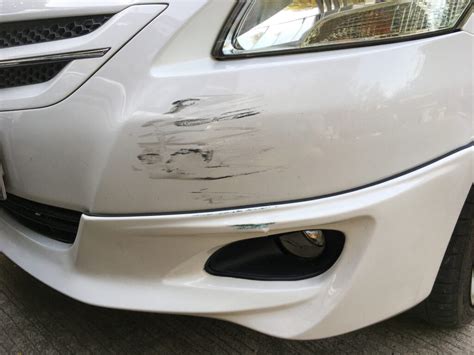Avoid Costly Mistakes: Bumper Scratch Repair Guide
A scraped bumper. It's a common car woe, a minor mishap that can quickly escalate into a major expense if not handled correctly. This comprehensive guide will walk you through repairing bumper scratches, helping you avoid costly mistakes and achieve professional-looking results, whether you tackle the job yourself or take it to a professional.
What Type of Damage Do I Have?
Before diving into repairs, accurately assess the damage. This crucial first step determines the best repair method. Is it a minor scratch affecting only the clear coat, a deeper scrape exposing the paint, or a significant dent?
- Minor Scratches (Clear Coat Only): These are often easily fixed with a simple rubbing compound or touch-up paint.
- Deeper Scratches (Paint Affected): These require more involved repair, potentially including sanding, priming, and repainting.
- Dents: Dents, especially larger ones, may necessitate professional attention or specialized tools like a dent puller.
How to Repair Minor Scratches (Clear Coat Only)
For minor scratches that haven't penetrated the paint, a simple DIY approach often suffices.
What You'll Need:
- Car Wash Soap: To thoroughly clean the affected area.
- Rubbing Compound: Choose a fine-grade compound for best results.
- Microfiber Cloths: Several clean cloths are essential for applying and buffing.
- Automotive Detailing Spray: To lubricate the surface during the rubbing process.
Step-by-Step Repair:
- Clean the Area: Wash and thoroughly dry the scratched area. Remove any dirt or debris that could scratch the surface further.
- Apply Rubbing Compound: Apply a small amount of rubbing compound to a clean microfiber cloth.
- Rub Gently: Using gentle, circular motions, rub the compound onto the scratch. Avoid excessive pressure.
- Buff and Polish: Once the scratch is less visible, buff the area with a clean microfiber cloth to remove any residue. Apply an automotive detailing spray to help with the buffing process. Repeat as needed.
- Inspect: Evaluate the results. If the scratch is still visible, you may need to repeat the process or consider a touch-up pen.
Repairing Deeper Scratches: When to Call a Professional?
Deeper scratches that reach the paint require more extensive repair. This often involves:
- Cleaning and Preparation: Thoroughly cleaning and preparing the surface for paint.
- Sanding: Sanding the affected area to create a smooth surface for the paint.
- Priming: Applying automotive primer to ensure proper paint adhesion.
- Repainting: Carefully applying touch-up paint to match your car's color.
- Clear Coat Application: Applying a clear coat to protect the new paint.
- Buffing and Polishing: Buffing and polishing to achieve a smooth, even finish.
Unless you have experience with automotive painting, attempting this at home can lead to an uneven finish, noticeable paint imperfections, or even damage to the surrounding paint. It's often best to leave this type of repair to a professional.
What About Bumper Dents?
Bumper dents can be challenging to repair at home. While minor dents might be addressed with a suction cup dent puller, larger or more complex dents require the expertise of a body shop. They possess the tools and skills to effectively repair dents without damaging the surrounding paint.
How Much Does Bumper Scratch Repair Cost?
Repair costs vary significantly depending on the severity of the damage and the repair method. Minor scratches can be fixed for under $20 with DIY methods, while deeper scratches or dents can cost hundreds of dollars at a professional body shop.
How Can I Prevent Future Bumper Scratches?
Prevention is always better than cure! Consider these tips:
- Park Carefully: Choose parking spots away from potential hazards like walls, posts, and other vehicles.
- Install Parking Sensors: Parking sensors provide audible warnings to help you avoid collisions.
- Use a Bumper Protector: Consider a bumper protector to shield your bumper from minor impacts.
By following this guide and understanding the different types of bumper damage, you can make informed decisions about repair and avoid costly mistakes. Remember, knowing when to call a professional is just as important as knowing how to tackle minor repairs yourself.

